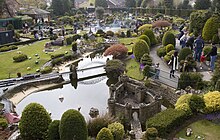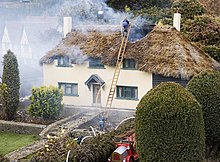Bekonscot: Difference between revisions
m Reverted edits by 60103henry to last revision by XLinkBot (HG) |
mNo edit summary |
||
| Line 25: | Line 25: | ||
There are six model villages set within the miniature landscape. These are entirely fictional towns, but many buildings within them are based on UK prototypes. Successive generations of modelmakers, gardeners and craftsmen have left their mark on their subjects, which display a wide range of vernacular [[architectural style]]s. |
There are six model villages set within the miniature landscape. These are entirely fictional towns, but many buildings within them are based on UK prototypes. Successive generations of modelmakers, gardeners and craftsmen have left their mark on their subjects, which display a wide range of vernacular [[architectural style]]s. |
||
Names of shops and other features include some |
Names of shops and other features include some entertaining puns, such as ''Lee Key Plumbers' Merchants'', ''Sam and Ella's Butchers'' and the ''Mark Owney Wireless and Gramophone stores''. Other model villages have run with the playful nature of the miniature businesses and it has become something of a model tradition. |
||
Over the last year, an on-going project to introduce more – smaller – moving models into the village has been underway. So far these have included a waving coal miner, a lady cleaning her window, a miniature children's play area, walking horses at a cider works, and even a painter falling |
Over the last year, an on-going project to introduce more – smaller – moving models into the village has been underway. So far these have included a waving coal miner, a lady cleaning her window, a miniature children's play area, walking horses at a cider works, and even a painter falling from a ladder. |
||
===Notable features include=== |
===Notable features include=== |
||
Revision as of 20:14, 17 November 2009


Bekonscot in Beaconsfield, Buckinghamshire, is the oldest original model village in the world.[1][2][3].
It portrays aspects of England mostly dating from the 1930s. Bekonscot has been run by the Church Army since 1978 and donates large amounts of money to charity. It has raised the equivalent of almost £5,000,000 so far and has been visited by more than 14,000,000 visitors.
Bekonscot was first created by Beaconsfield resident, accountant Roland Callingham (1881-1961), in the 1920s. Roland developed the master plan for his miniature empire as an addition to his large back garden, drawing in help from his staff: the gardener, cook, maid and chauffeur. Together they developed the model landscape portraying rural England at the time. The swimming pool became the first "sea" and the undulating rockeries were built up as hills. Bassett-Lowke, the well-known large-scale model railway manufacturers, were commissioned to build an extensive 7.25 gauge railway network[4], which exists to this day. Callingham named the village 'Bekonscot' after Beaconsfield and Ascot where he previously lived.
It was not conceived as a commercial visitor attraction but as a plaything to entertain Roland and his guests. It was only after 1930 that its existence became widely known, catching the imagination of the press and public alike. Frequent newsreels such as Pathe, international and national newspaper coverage ensure a steady stream of visitors, all of whom were invited to make a donation to the Railway Benevolent Institution.
Legacy
Bekonscot is acknowledged to be the inspiration for many other model villages and miniature parks across the world, including Babbacombe, Southport, Tucktonia, Madurodam, Bourton-on-the-Water, Wimborne, Great Yarmouth, Clonakilty and Mini-Europe. As such, it is regarded as the "grandfather" of the model village and miniature park movement.[5]
The village expanded in size throughout the first half of the 20th Century. Callingham sold off much of the land surrounding the model village, all of which is now a housing estate.[5] The village is now entirely surrounded by urban development so further expansion is impossible.
Bekonscot popularised the miniature park movement, put Beaconsfield on the map and has a continuing financial legacy in donations to charitable organisations both national and local.[5]
Miniature landscape



The site is approximately two acres of which just over half is a miniature 1:12 landscape. Buildings are constructed in natural materials, concrete, or dense foamboard; many are originals from the 1920s.
There are six model villages set within the miniature landscape. These are entirely fictional towns, but many buildings within them are based on UK prototypes. Successive generations of modelmakers, gardeners and craftsmen have left their mark on their subjects, which display a wide range of vernacular architectural styles.
Names of shops and other features include some entertaining puns, such as Lee Key Plumbers' Merchants, Sam and Ella's Butchers and the Mark Owney Wireless and Gramophone stores. Other model villages have run with the playful nature of the miniature businesses and it has become something of a model tradition.
Over the last year, an on-going project to introduce more – smaller – moving models into the village has been underway. So far these have included a waving coal miner, a lady cleaning her window, a miniature children's play area, walking horses at a cider works, and even a painter falling from a ladder.
Notable features include
Railways


Bekonscot is famed for its complex outdoor model railway (in Gauge 1)[4], possibly the largest public garden railway in the UK, at ten scale miles. A custom-built PC-based interface controls the block signalling system, directing up to 12 trains at any one time on prototypical routes. In addition there are two manual lever frames, one ex-BR and the other from London Underground. The British Rail lever frame is still in use as a manual override for the trains. Some original Bassett-Lowke stock from the 1930s is still in daily use, albeit with new running gear. Many of these trains have significant historical value. Some have been running for over 50 years, each covering about 2,000 miles (3,200 km) per year.[6]
A miniature railway giving passenger rides was built along the perimeter of the site in 2001. Of 7.25 gauge this was extended in 2004 to a new terminus. Three battery-electric locos haul trains: one a Bo-Bo tram, one a Pfeifferbahn-based engine and one a large 0-4-0 built by Maxitrak. The latter was named "Sprocket" in 2004; the third birthday of the railway and the 75th of the Model Village.
Currently there are 12 full-time staff who maintain the village throughout the year; during the open season a further 20 or so seasonal staff are employed.
In popular culture
Bekonscot features prominently in the Will Self short story Scale; was the setting of Beaconsfield-resident Enid Blyton's short story The Enchanted Village; and is thought to have inspired the series of Borrowers books by Mary Norton.
The non-fiction bestseller Forever England by Liam Bailey is a photographic study of the village's miniature characters, whilst Bollocks to Alton Towers, by Hazely et al., celebrates the quirkiness and eccentricity of Bekonscot.
The 2007 song Country Life by Luke Haines mentions Bekonscot in its liner notes and lyrics use the village as an extended metaphor.
Owing to Bekonscot's proximity to London and the southeast-based media industry, Bekonscot features frequently on television and radio.
Also, Queen Elizabeth II visited Bekonscot when she was young.
Television appearances include:
- Blue Peter (multiple times)
- Treasure Hunt
- Midsomer Murders (the episode Small Mercies, aired 28 October 2009)
- BBC Countryfile
- Various television news items
- BBC Working Lunch
- McDonald's advertisement
- One Foot in the Past introductory sequence
- Muffin the Mule
- BBC sitcom 'Dad'
- Discovery Home and Leisure's and Leisure's 'Garden Railway' series
References
- Dunn, Tim. Bekonscot - Historic Model Village & Railway. Merve Hill. © 2009 Jarrold Publishing, part of Heritage House Group, Norfolk. ISBN 978-0-85101-435-7. Retrieved 04-10-2009.
{{cite book}}: Check date values in:|accessdate=(help); Unknown parameter|coauthors=ignored (|author=suggested) (help)
Notes
- ^ Bekonscot - Historic Model Village: 2009, Page 2
- ^ BBC - Beds, Herts and Bucks Just for Fun - Bekonscot Model Village
- ^ Bekonscot Model Village on AboutBritain.com
- ^ a b Bekonscot Light Railway website
- ^ a b c Bekonscot - Historic Model Village: 2009, Page 34
- ^ Bekonscot - Historic Model Village: 2009, Page 9
External links
- Official website
- The Guardian article
- Bekonscot: The Tim Dunn Interview
- Bekonscot Model Railway – Driver's eye view on YouTube – a journey round the railway filmed from a locomotive
